As a farmer, you know the importance of proper hydration for your goats’ health and well-being. Providing clean and accessible water is crucial for digestion, milk production, and overall health.
This guide will walk you through everything you need to know about goat waterers, from their importance, types, and considerations to installation, maintenance, troubleshooting, frequently asked questions, plus tips to maximize your herd’s water intake. By the end of this guide, you’ll be equipped with the knowledge and tips you need to choose and maintain the right goat waterer for your herd.
Key Takeaways:
- Goat waterers are essential for maintaining the health and well-being of your herd.
- The average goat needs between 3-5 gallons of water per day, depending on size, activity level, and climate.
- There are various types of goat waterers available in the market and designs, ranging from simple buckets to automatic watering systems, each with unique features and benefits.
- When choosing a goat waterer, consider factors like capacity, durability, ease of cleaning, and accessibility for goats.
- Maintaining and cleaning goat waterers regularly is crucial for preventing contamination and ensuring fresh water.
- Knowing how to troubleshoot common issues with goat waterers can save you time and money.
What is a Goat Waterer and Why is it Important?
A goat waterer is a device or system designed to supply water to goats in a controlled and efficient manner.
It ensures that your goats have continuous access to clean and fresh water any time they need it
Proper hydration is crucial for goats’ digestive health, milk production, and overall well-being. Without a reliable water source, goats may suffer from dehydration, constipation, or other health problems.
By investing in a reliable goat waterer, you can rest assured that your herd is getting the water they need to thrive.
Benefits of goat waterers include;
- Some designs of goat waterers automate the process of providing water, saving you time and effort on daily watering tasks. This is especially beneficial if you have a large herd, as it ensures that all goats have access to water without manual intervention.
- Accommodation of Goats’ Anatomy: Goat waterers are designed with goats’ specific drinking habits in mind. They are positioned at an appropriate height and depth, making it easier for goats to drink comfortably and preventing unnecessary strain on their necks.
- Prevention of Water Wastage and Keeping Water Clean: Automatic waterers and properly designed manual waterers help prevent water wastage and keep the water clean. Goats tend to dirty their water sources quickly, but goat waterers with covers or float valves minimize contamination and reduce the frequency of water changes.
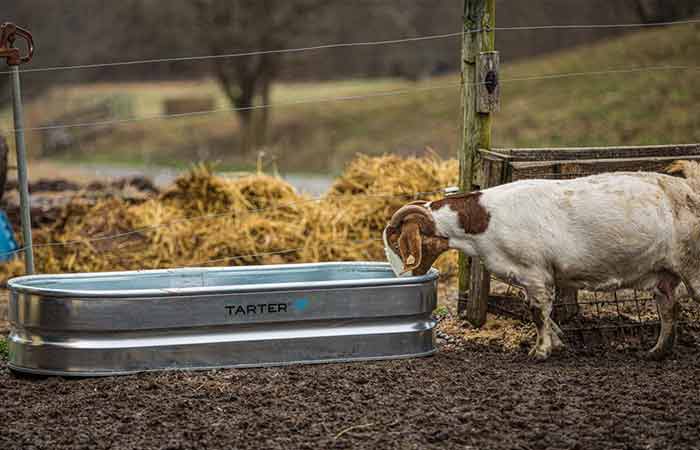
Types of Goat Waterers
From automatic, heated to basic bucket-style, there are several types of waterers available in the market. Each has its own unique features and benefits that cater to the different budgets, needs and preferences of goat farmers. Here are some of the most popular types of goat waterers:
Automatic Goat Waterers
An automatic goat waterer is a type of watering system designed to provide goats with a constant supply of clean, fresh water without the need for frequent refilling. Here are some key features of automatic goat waterers:
Reservoir – They contain a large reservoir tank or are hooked directly to a water line to hold a substantial volume of water. Common sizes range from 20-100 gallons.
Self-refilling – A float valve is used to automatically refill the bowl or trough when the water level drops. This maintains a constant supply.
Drinking basin – Goats access the water from a bowl or trough, which refills with water as they drink. Basins are made of durable plastic or metal.
Freeze protection – Many models include built-in heating elements and insulation to prevent freezing in winter. Thermostats control the temperature.
Filters – Some systems have filters to remove debris and sediment before water fills the drinking basin. This improves water cleanliness.
Mounting – Automatic waterers are designed for mounting on fence lines or walls at goat height. Some have concrete bases.
Power – Electric models require access to power to run heating elements, float valves, and filters. Solar-powered ones are also available.
Materials – Made from sturdy, goat-proof materials like galvanized steel, concrete, or heavy-duty plastic.
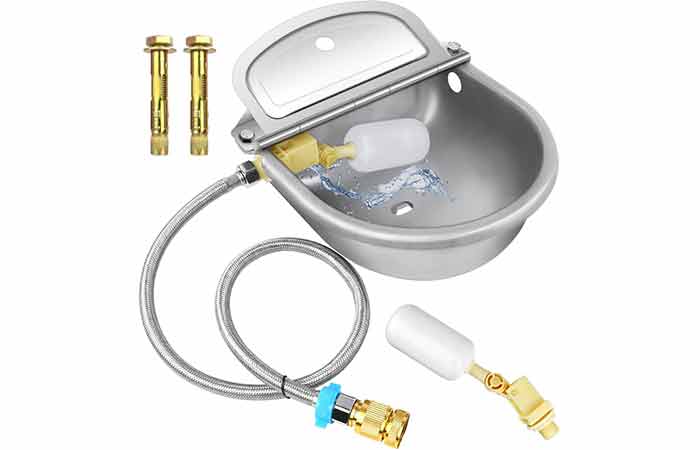
With an automatic waterer, goats always have access to as much clean water as they need. The initial investment is higher than simple buckets, but automatic waterers can save significant time by eliminating daily water hauling and refilling. They’re especially useful for large herds.
For larger herds or hands-off convenience, automatic waterers are a great solution. These consist of a large reservoir or connection to plumbing that automatically dispenses water into a tray or bowl as goats drink. Float /copper valves maintain the proper water level at all times.
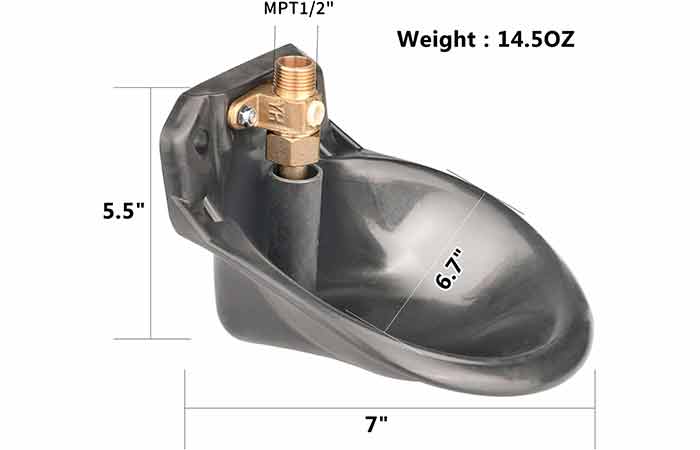
Here are some pros and cons to consider when using an automatic goat waterer:
Pros
- Provides constant access to water 24/7. Goats always have fresh clean water available.
- Saves labor since no daily filling or hauling water is required. Convenient for large herds.
- Adjustable float keeps water at an optimal level. Reduces waste.
- Most have filters to remove debris and sediment. Improves water cleanliness.
- Heating elements in some models prevent freezing in winter. Allows year-round use.
- Durable, goat-proof materials made to withstand wear and tear. Long-lasting.
- Multiple goats can drink at once from larger trough-style basins.
- Can be mounted at accessible goat height. Ergonomic design.
Cons
- More expensive upfront cost than simple buckets, troughs or manual refill waterers.
- Require access to electricity and proper wiring for heated models.
- Proper installation is important for proper drainage and function.
- Float valves and heating elements may eventually malfunction and need repair.
- Algae may build up in basins without proper cleaning. Needs maintenance.
- Could freeze in severe winters despite heating elements. May need backup plan.
- Large-size designs may require sufficient space for installation. Not as portable.
- Goats playing on them could damage components. Needs durability.
Overall, the labor savings and constant water access of automatic waterers can outweigh the higher upfront investment for many goat owners, especially those with large herds. But they require space, power access, and occasional maintenance to maximize their usefulness.
Goat Watering Troughs
Troughs are a popular choice for farmers with a large number of goats and huge space. They are basically large and long open containers made from durable materials like concrete or metal that last a long time. Smaller designs are mostly made of plastic.
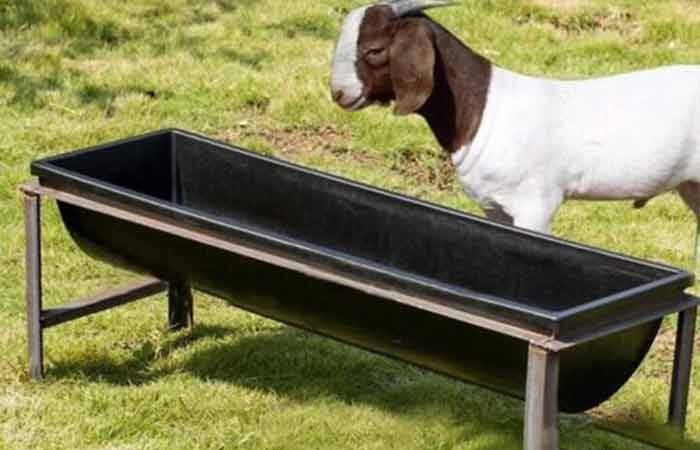
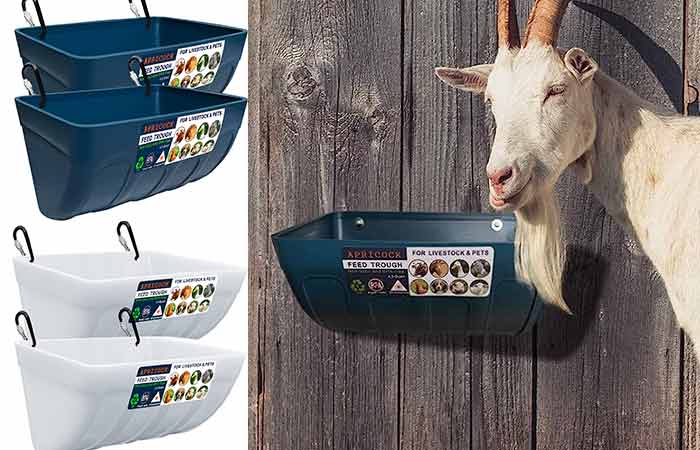
The large options allow multiple goats to drink at the same time, smaller designs can accommodate one or two goats.
They are easy to refill and clean but may require frequent refilling as they tend to attract debris and can become contaminated
Open troughs need vigilant cleaning and maintenance to provide goats with clean fresh water. Closed, automatic troughs are more sanitary but cost more upfront.
Here are some pros and cons of using watering troughs for goats:
Pros
- Allows multiple goats to drink at once. Good for large herds.
- Troughs can be long, allowing space for more goats. Reduces competition.
- Easy to clean and disinfect regularly. Smoother surfaces limit biofilms.
- Raised edges help contain water spillage and runoff.
- Durable materials like concrete or metal last a long time.
- Available in multiple designs including, small/large, open/closed, auto, heated etc.
- Can be placed undercover to keep the water cool and clean.
Cons
- Open troughs allow debris and dirt to contaminate water.
- Stagnant water can promote algae growth and disease.
- Metal or concrete is cold in winter. Goats may avoid drinking.
- Automatic refillers and heated models are more expensive.
- The large size requires more space in a barn or pasture.
- Must be cleaned frequently to keep clean.
- Goats can climb into troughs and foul the water.
- Constant refilling or high goat traffic can create muddy conditions.
Bucket Waterers
The most basic and affordable type of goat waterer is a bucket or tub with either a spout or nipple attachment for the goats to sip from. These are easy to set up – just place the bucket in the goat pen or pasture and fill it with water. The spout or nipple allows goats access to the water supply while helping to keep dirt and debris out.

Pros
- Very inexpensive and simple to set up
- Portable – can be moved wherever needed
- Easy to clean and disinfect regularly
Cons
- Requires frequent refilling as goats drink
- Can spill or tip over easily
- Water can collect algae, dirt, and other contaminants
Heated Goat Waterers
In colder climates, keeping water from freezing all winter is a challenge. Heated watering systems use an electric heating element built into an insulated bucket or trough to maintain liquid water even when temperatures drop below freezing.
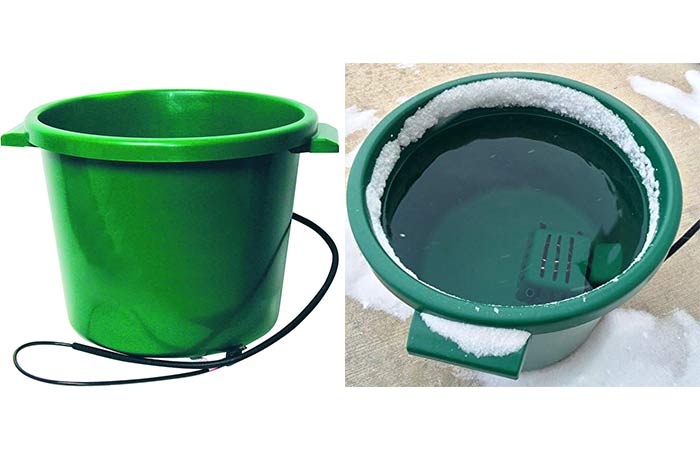
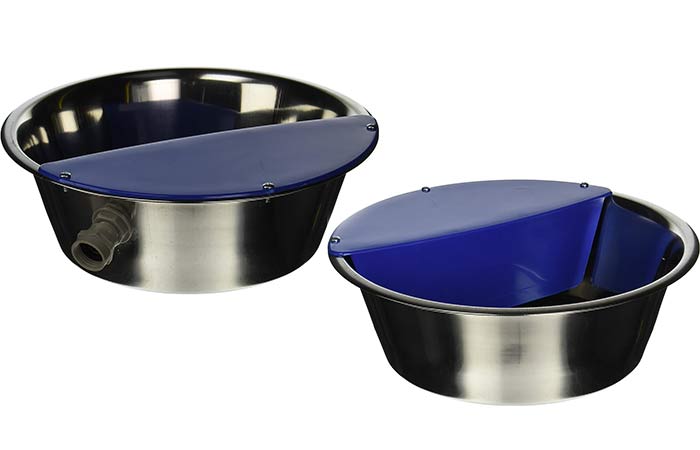
Pros
- Prevents water from freezing in frigid weather
- The insulated bucket also helps keep water cool in summer
- Electric heating element conveniently plugs in
- Keeps water clean and debris-free
Cons
- More expensive than unheated buckets
- Requires access to electricity
- The heating element may malfunction over time
Simple and Inexpensive DIY Goat Watering System
Creating a simple and inexpensive automatic watering system for goats and sheep is an effective way to streamline the watering process while minimizing costs. Following are the supplies you need and the steps.
Materials Needed:
- A large bucket or barrel (capacity depends on herd size)
- A float valve (available at agricultural supply stores)
- PVC piping and fittings
- Hose adapter
- Hose
- Anchoring materials (brackets, screws, or straps)
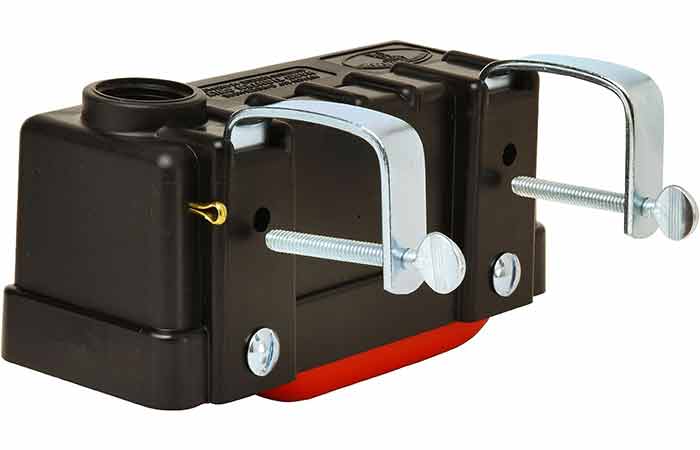
Steps:
- Drill a Hole: Drill a hole near the bottom of the bucket or barrel to accommodate the float valve.
- Install the Float Valve: Insert the float valve into the drilled hole and secure it in place according to the manufacturer’s instructions.
- Attach PVC Piping: Connect the PVC piping to the float valve. The piping will deliver water from a nearby water source to the bucket or barrel.
- Add Hose Adapter: Attach a hose adapter to the end of the PVC piping to connect the hose.
- Attach Hose: Connect the hose to the hose adapter, and extend it to a suitable location for watering.
- Secure the Bucket/Barrel: Position the bucket or barrel in a shaded area near your goats’ grazing or resting area. Secure it in place using brackets, screws, or straps.
- Connect Water Source: Connect the hose to a reliable water source with a constant supply. Ensure the hose is secured and doesn’t kink or get obstructed.
Other Goat Watering Systems Include;
Gravity flow waterers: Utilize gravity to deliver clean water. A large barrel or tank is situated uphill from the goat shelter. A hose runs downhill from the barrel to dispensers or troughs in the goat area.
Pros
- No electricity required
- Water stays clean in a covered barrel
- Simple, effective design
- Can service multiple access points
Cons
- Initial setup can be tricky
- Barrel must be uphill from the pens
- Not easily portable
Natural Spring Waterers: Provide fresh flowing water from a natural spring or gravity-fed pipe using no electricity. Requires an uphill water source with sufficient pressure. Water flows into a collecting bowl or trough.
Hose-End Waterers: Low-cost option to easily dispense water into a trough or container. Attach a hose to a faucet outlet and adjust the valve for a steady stream of flowing water. Requires supervision to avoid messes.
Considerations for Choosing the Right Goat Waterer
Choosing the right goat waterer is essential for maintaining the health and well-being of your goats. Here are some factors to consider when selecting a suitable goat waterer for your farm:
| Factor | Details |
| Capacity | Consider the size of your herd and how much water they consume. Choose a waterer that can hold enough water to meet their daily needs. |
| Durability | Goats can be rough on waterers, so it’s important to choose a sturdy and durable option that can withstand their activity. |
| Ease of cleaning | Clean waterers are essential for preventing contamination and promoting good hygiene. Choose a waterer that is easy to clean and sanitize regularly. |
| Accessibility | Waterers should be easily accessible for your goats to drink from, especially for younger or smaller goats. Consider the height and size of the waterer, as well as its location within the barn or pasture. |
| Existing infrastructure | Access to plumbing or electricity allows for more options. Off-grid farms have fewer choices. |
| Budget | Simple buckets are cheapest. Heated and automatic systems have higher upfront costs. |
| Climate | Colder regions need a way to prevent freezing in winter. Areas with very hot summers need to keep water cool |
| Labor | How much time do you want to spend on refilling and cleaning water systems? Automatic and gravity flow systems are the most hands-off. |
By considering these factors when choosing a goat waterer, you can ensure that your goats have access to clean, fresh water and maintain good health.
Installing a Goat Waterer Properly+Tips
Now that you have chosen the right goat waterer for your farm, it’s time to install it properly. Follow these steps to ensure a seamless installation:
- Choose Location – Place waterers in a central spot easy for the herd to access. Provide multiple water sources in larger pastures. Site them near fences, feeders or barns goats frequent.
- Level Surface – Select a flat area so the waterers sit evenly. Uneven ground can cause leaking or structural issues.
- Stable Footing – Install water buckets and troughs on a hard-packed gravel, concrete, or compact soil base. This prevents standing water and muddy conditions.
- Water Supply – Run water lines underground to prevent freezing. Attach a flexible hose or PVC pipe to the water source and the waterer. Allow sufficient pipe diameter for water pressure. Install cut-off valves to easily disconnect lines for maintenance.
- Test the waterer. Fill the waterer with water and check for leaks. Check the water pressure and adjust if necessary.
- Train your goats. Show your goats how to use the waterer by dipping their noses in the water. Ensure they know how to drink from the waterer before leaving them unsupervised
Tips
No matter which waterer you choose, follow these tips for proper setup and maintenance:
- Install a drain valve to allow for easy cleaning and draining of the waterer. Redirect the drainage away from the waterer to prevent contamination.
- Flow Rate – Optimize refill rate to keep pace with consumption. Slow flows cause frustration in large herds. Fast and unregulated flows can waste water.
- Mount water containers 2-3 feet high to discourage goats from soiling the water or to minimize contamination. For a natural stream waterer, position collecting basins above ground level.
- If possible, place waterers in a sheltered area to protect components from sun, rain and cold winds. Provide insulated covers for added winter protection.
- In winter, insulate lines and take preventative measures to avoid freezing.
- In winter, insulate lines and take preventative measures to avoid freezing.
- Make sure water volume and flow rate can accommodate peak demand times.
- Adjust height appropriately as kids grow to allow easy access. Provide sturdy platforms for kids who can’t reach
Maintaining and Cleaning Goat Waterers
Regular maintenance and cleaning of goat waterers not only ensures that your goats stay healthy and hydrated but also the longevity and effectiveness of the waterer. Here are some tips to help you keep your waterers in good condition:
1. Clean the Waterer Regularly
It’s important to clean your goat waterer frequently to ensure it remains free of algae, bacteria and contaminants.
Use a mild dishwashing detergent and warm water or a solution of bleach/vinegar to clean the waterer at least once a week. Scrub the sides and bottom of the waterer thoroughly to remove any dirt and debris that may have accumulated.
Rinse the waterer well to ensure that all soap residue is removed. Completely drain for deep cleanings.
2. Change the Water Frequently
Goats prefer fresh water, and stagnant water can quickly become a breeding ground for bacteria and algae. Change the water in your goat waterer at least once a day, especially during hot weather. This helps to prevent the growth of bacteria and ensures that your goats always have access to clean, fresh water.
3. Inspect the Waterer for Damage
Regularly inspect your goat waterer for any signs of damage or wear and tear. Cracks or leaks in the waterer can cause water to spill out, resulting in wet bedding and a higher risk of bacterial growth. Replace the waterer if you notice any damage or wear and tear.
4. Use a Water Filter
If your water source contains high levels of minerals or other impurities, consider using a water filter to remove them. This will help to prevent mineral buildup in the waterer, which can clog the valves and prevent water from flowing properly.
5. Water Testing
Periodically test water for unsafe bacteria levels, algae minerals, and proper pH. If you notice any signs of algae or bacteria, clean the waterer thoroughly and change the water more frequently to prevent further growth. Adjust the ph and mineral content accordingly
6. Drainage
Prevent standing water by installing drain plugs or vacuuming out troughs. Check for leaks around fittings, pipes, and water lines.
7. Ice Removal
Break up accumulated ice in waterers daily during winter. Use safe de-icing products if needed. Insulate lines and consider heated models.
8. Part Replacement
Replace worn parts like float valves, fill tubes, heating elements and hose connections when defective. Keep extras on hand.
9. Yearly Maintenance
Conduct routine maintenance in spring and fall. Check all systems, repair leaks, clear debris from lines, and replace worn parts.
By following these tips, you can ensure that your goat waterer remains in good condition and that your goats have access to clean, fresh water at all times.
Troubleshooting Common Goat Waterer Issues
While goat waterers are designed to function smoothly, there may be times when you encounter issues that require troubleshooting. Here are some common issues you may face with goat waterers and how to resolve them:
| Issue | Troubleshooting Tips |
| Leakage | Check if there are any cracks or damage to the waterer that may be causing the leak. Tighten any loose fittings or connections. If the issue persists, consider replacing the waterer. |
| Clogging | Remove the waterer and clean it thoroughly. Check for any debris or mineral buildup that may be causing the clog. Consider using a water filtration system to prevent future clogging. |
| Malfunctioning | Check the power source and ensure that the waterer is properly connected. Clean the waterer and check for any damage. If the issue persists, consider contacting the manufacturer for repair or replacing the waterer. |
Remember, it is important to address any issues with goat waterers promptly to ensure that your goats have access to clean and fresh water at all times. Regular maintenance and checking can prevent minor issues from becoming major problems.
Watering Goat Tips- Water Intake & Management Strategies
Aside from selecting and maintaining a suitable goat waterer, there are additional tips and recommendations to ensure your goats stay hydrated and healthy.
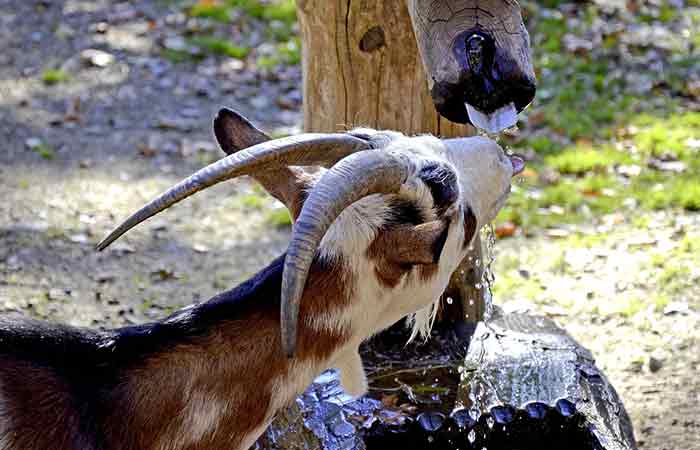
Understanding How Much Water Goats Need
The average water intake for a goat per day is:
- 3-5 gallons for adult goats
- 1-2 gallons for young goats
As a general rule, a goat should consume around 4-8 cups of water per 100 lbs of body weight each day. Lactating does require double that amount. Here are some of the factors that determine how much water a goat needs each day:
| Factor | Details |
| Weight | Larger goats need more water than smaller goats |
| Lactation | Milking goats need substantially more water, up to 4-8 gallons per day |
| Activity Level | Goats that are more active need more water to replenish |
| Temperature | Goats drink more water when temperatures are hot |
| Diet | Goats eating dry hay need more water than those on fresh pasture |
| Health and Stress Levels | Sick or stressed goats may drink more water as a response to their condition. |
| Water Quality | Goats will drink more if the water is fresh, clean, and free from contaminants. |
Tips to ensure goats stay hydrated
- Provide unlimited clean, fresh water 24/7
- Provide extra water on hot days
- Offer water after strenuous activity or exercise
- Consider a goat’s needs at different life stages
- Encourage water intake: Some goats may require encouragement to drink enough water. Providing fresh, clean water and adding electrolytes or salt to their diet can help stimulate their thirst and keep them hydrated.
- Winterize waterers: During cold months, it’s essential to prevent waterers from freezing. You can use insulated waterers or add a heater to prevent the water from freezing.
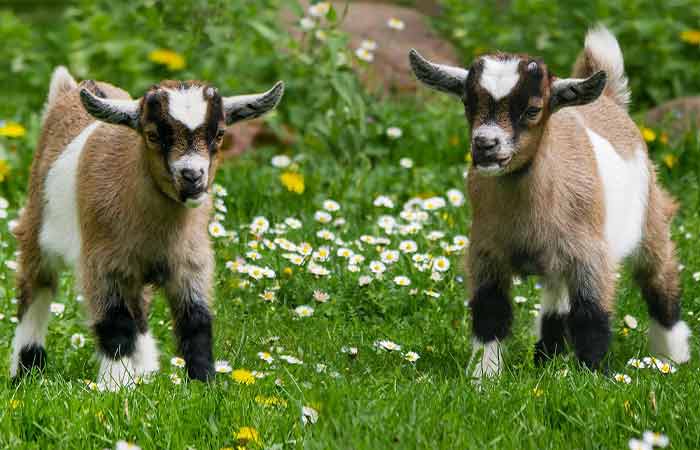
Signs of dehydration in goats
Here is a summary of the key signs of dehydration in goats:
- Dry nose, mouth, eyes
- Sunken eyes
- Loss of skin elasticity
- Fatigue, weakness
- Decreased urine output
- Constipation
- Rapid breathing and heartbeat
- Fever
- Muscle tremors
- Unsteady gait
Goats exhibiting multiple signs of dehydration, especially lethargy, rapid pulse, fever, and unsteadiness, require urgent veterinary attention to avoid a life-threatening situation.
For mild cases, providing access to fresh water, oral electrolytes, wet forage, shade, and fans can help restore fluid balance. Identifying and addressing the underlying cause is also important. Catching dehydration early is key.
Monitoring intake
Monitoring daily water intake can help identify potential health issues in individual goats. Sudden changes in consumption can be a symptom of various problems.
Observation: Observe your goats throughout the day to see how often they visit the water source and how much they drink.
Measuring Water Usage: Measure the water level in the trough or container before and after filling it. This will give you an idea of how much water your goats are consuming daily.
Keeping Records: Maintain a record of each goat’s water intake to detect any changes in drinking patterns.
Access to Water: Ensure that all goats have easy access to the water source. In large herds, consider providing multiple water stations to prevent overcrowding and ensure all goats can hydrate comfortably.
Water Management Strategies for Different Goat Farming Systems
Strategies for Small-scale Goat Farms
Installing multiple water stations throughout your farm is also advisable, especially if you have a larger herd. This allows for more convenient access to water, reducing competition and potential conflicts among goats.
Water Considerations for Pasture-based Goat Systems
For goat farms that primarily rely on pasture grazing, water planning becomes even more critical. Dry roughages require more water than fresh green feeds. During the hot summer months, when dehydration becomes more of a concern, providing ample access to clean water at all times is vital. This can be achieved through the use of watering troughs or automatic waterers strategically placed in various areas of the pasture.
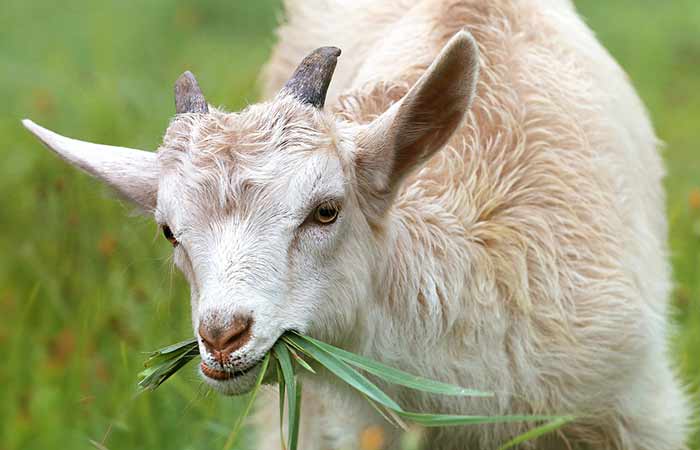
Efficient Water Usage in Intensive Goat Farming
In intensive goat farming systems, where goats are housed in confinement, efficient water usage is paramount. Automatic waterers are highly recommended for these setups, as they regulate and provide a constant supply of fresh water without the risk of contamination or wastage. Additionally, implementing a water management system that recycles and reuses water can greatly reduce water consumption and expenses.
Remember, providing clean and fresh water to your goats is essential for their health and well-being. By selecting a suitable goat waterer and maintaining it properly, you can ensure that your goats stay hydrated, happy, and productive.
If you have any further questions or concerns about goat waterers or need any assistance, do not hesitate to consult with your local veterinarian. They can provide you with additional guidance and recommendations based on your specific needs and circumstances. Here are some frequently asked questions about goat waterers:
FAQs
Q: Are there Downsides/Cons of Using Goat Waterers?
A: some potential downsides include high upfront costs, extensive installation requirements, necessary maintenance, susceptibility to freezing, large size, power access for electric units, the potential for damage from goats, and excess mud from spills.
With careful selection, proper setup, routine maintenance, and supervision, most of these cons can be prevented or managed. But farmers should weigh the pros and cons when selecting a watering method to best suit their budget and needs.
Q: How much Water does a Goat Need Each Day?
A. On average, goats need 3-5 gallons of fresh clean water per day. Lactating does require more, around 4-8 gallons daily.
Q: How do you keep water warm or from freezing in winter?
A. Use a heated water bucket or automatic waterer with built-in heating elements or use a tank de-icer. Insulate lines and the water container, place the water in a sunny spot, or add salt to the water.
Q: Where should you position a Goat Waterer?
A. Put the waterers in locations that are accessible and shaded locations at goat height. Have multiple stations for convenience.
Q: How often should you Clean a Goat Waterer?
A. Clean and disinfect waterers frequently, at least weekly, to prevent algae buildup and contamination.
Q: What if my Goat is not Drinking Enough Water?
A. Flavor water with electrolytes, provide wet forage, check for dental issues, monitor urine output, and consult a vet if needed.
Q: How do you Teach a goat to Drink Water?
- Start with small amounts of water in a shallow bucket or pan. Let the goat investigate and taste the water.
- Flavor the water with a small amount of molasses, apple juice or electrolytes to encourage drinking.
- Demonstrate drinking by dipping your fingers in the water and putting them in the goat’s mouth.
- Reward them with treats when they start licking or drinking the water. Praise them.
- Gradually transition to deeper buckets and introduce automatic waterers.
Q: How do I keep my Goat’s Water Warm?
A. Use heated water buckets with built-in heating elements, insulate any exposed water lines, and place stations in sheltered areas blocked from the wind. Break surface ice frequently, add plastic balls to prevent freezing, provide ample volumes of water so liquid remains below icy patches, and consider heat tape for lines and buckets
Citations:
- https://extension.psu.edu/so-you-want-to-raise-sheep-or-goats
- https://goats.extension.org/goat-nutrition-water/
- https://www.ncbi.nlm.nih.gov/pmc/articles/PMC1189275/
- https://www.sciencedirect.com/topics/agricultural-and-biological-sciences/water-troughs
- https://dpwaterer.com/drinking-post-training-guide/
- https://www.dummies.com/home-garden/hobby-farming/raising-goats/supplying-your-goats-with-water/
- https://simplelivingcountrygal.com/encourage-goats-drink-more-water/
- https://education.nsw.gov.au/teaching-and-learning/animals-in-schools/animals-in-schools-species/goats/goats-food-and-water
- https://www.oakhillhomestead.com/2018/11/how-to-keep-livestock-water-from.html






